Abstract
1. L-Arginine (100-1000 mg kg-1) administered orally (p.o.) or intraperitoneally (i.p.), but not intracerebroventricularly (i.c.v., 0.08 mg per mouse), reduced the antinociceptive effect of morphine (0.5-10 mg kg-1 s.c.) assessed in mice using three different tests: hot plate, tail-flick and acetic acid-induced writhing. D-Arginine (up to 1000 mg kg-1 p.o. or i.p.) was ineffective. 2. NG-Monomethyl-L-arginine (L-NMMA, 5-50 mg kg-1 i.p.) and NG-nitro-L-arginine methyl ester (L-NAME, 5- 30 mg kg-1 i.p.), but not NG-nitro-D-arginine methyl ester (D-NAME, 30 mg kg-1 i.p.), reversed in all assays the effect of L-arginine on morphine-induced antinociception. 3. Morphine (10 mg kg-1 s.c.), L-arginine (1000 mg kg-1 p.o.) or L-NAME (30 mg kg-1 i.p.), either alone or in combination, did not produce changes in locomotor activity or sensorimotor performance of animals. 4. These results suggest that the L-arginine-nitric oxide pathway plays a modulating role in the morphine-sensitive nociceptive processes.
Full text
PDF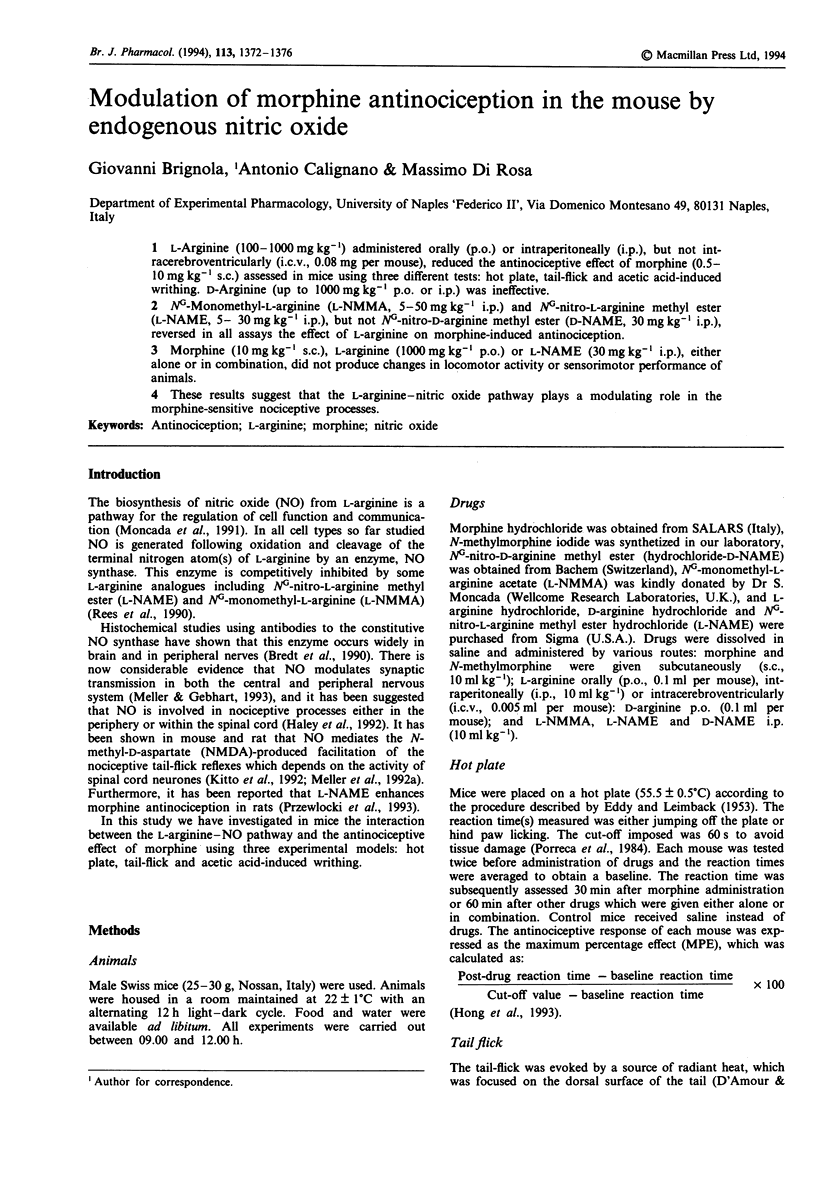
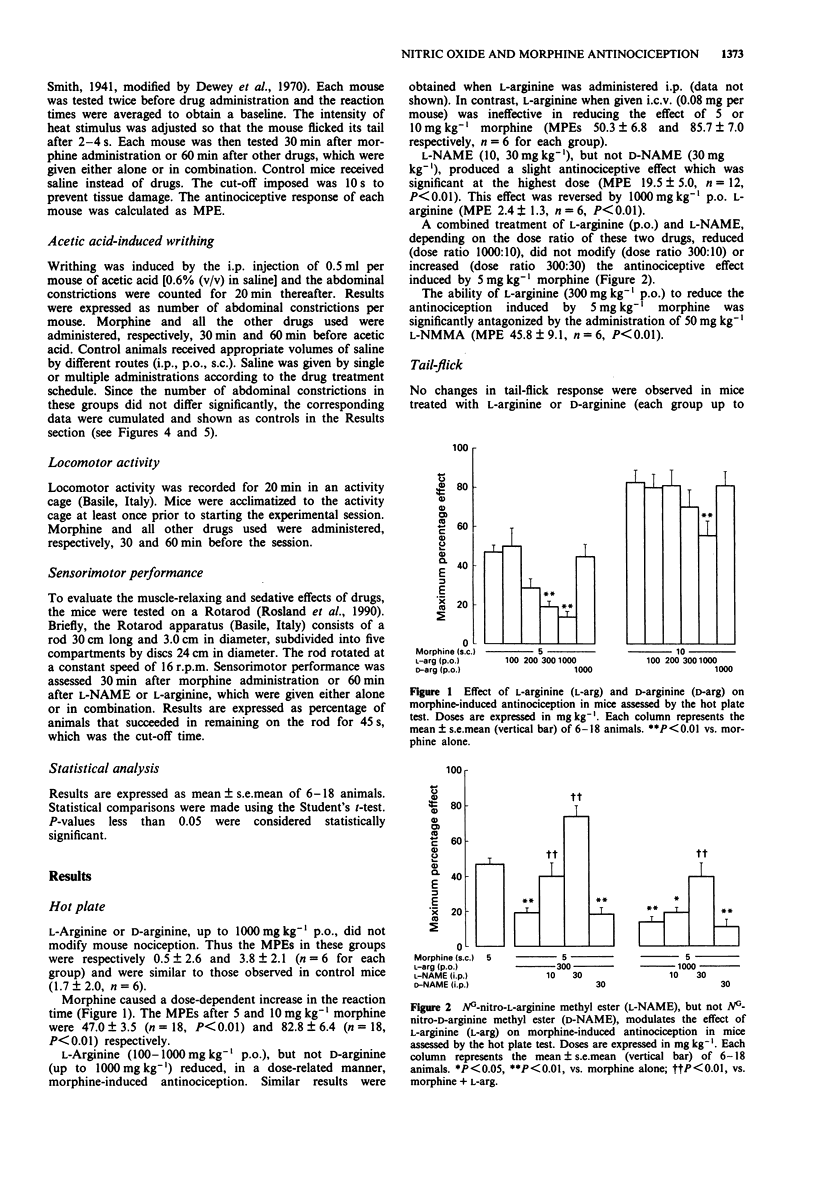
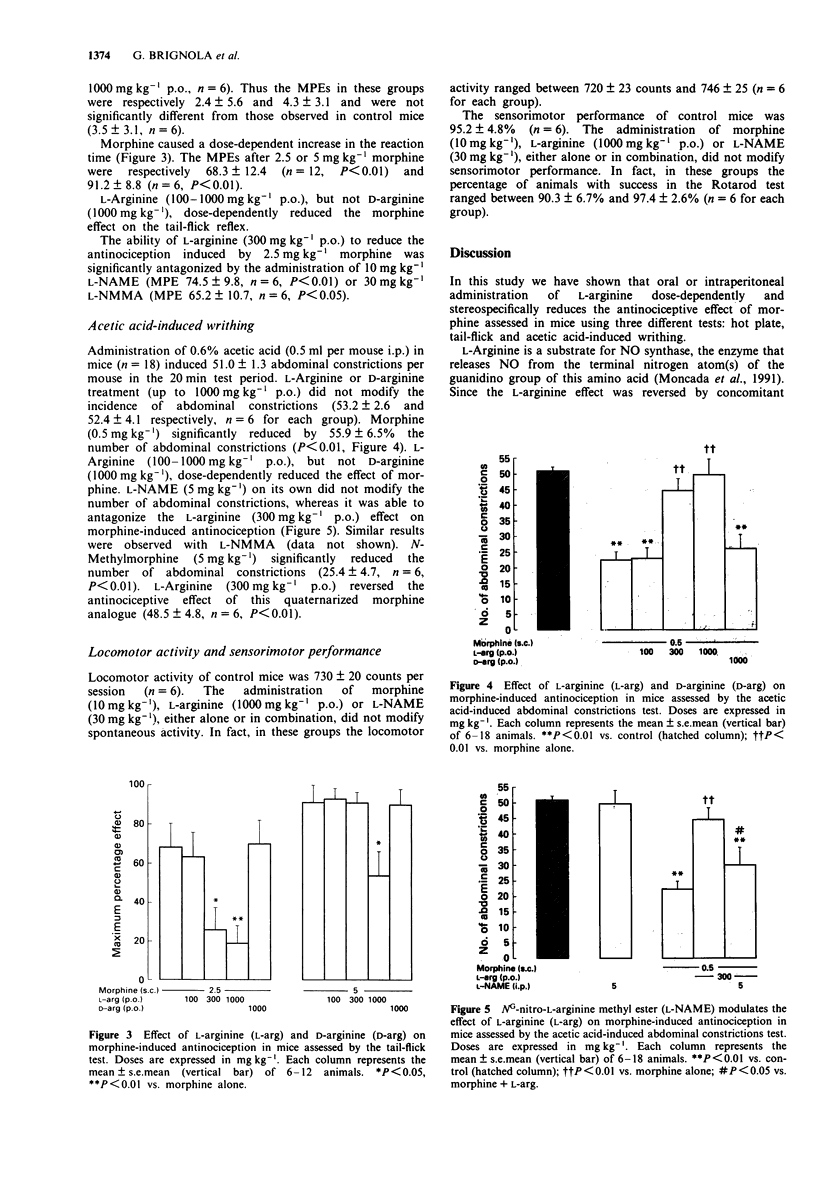
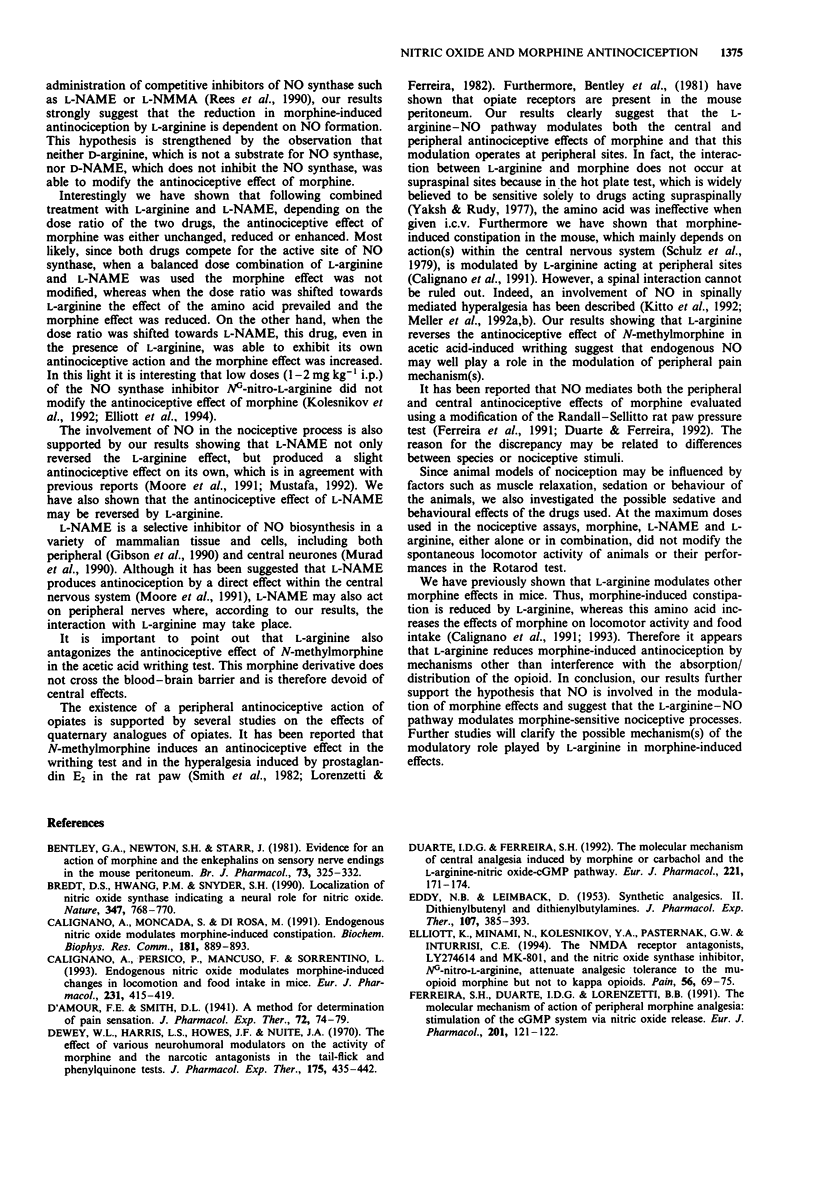
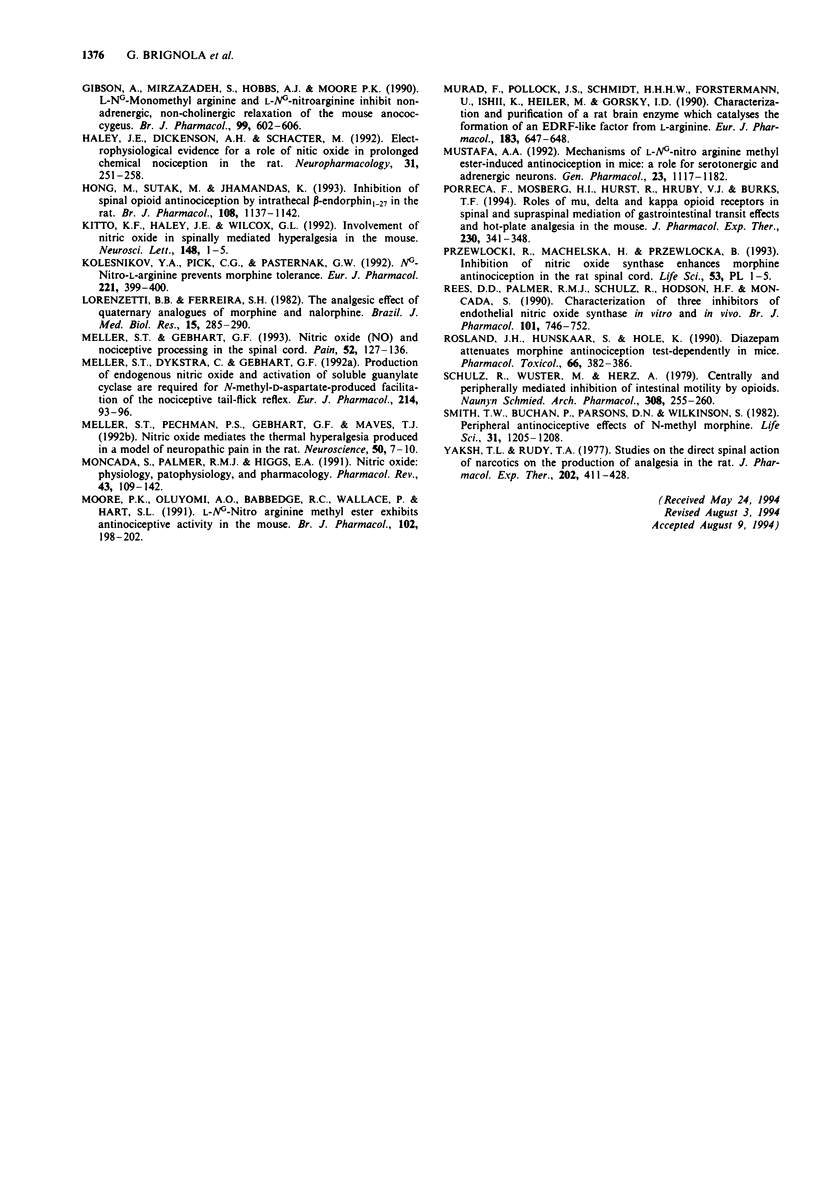
Selected References
These references are in PubMed. This may not be the complete list of references from this article.
- Bentley G. A., Newton S. H., Starr J. Evidence for an action of morphine and the enkephalins on sensory nerve endings in the mouse peritoneum. Br J Pharmacol. 1981 Jun;73(2):325–332. doi: 10.1111/j.1476-5381.1981.tb10425.x. [DOI] [PMC free article] [PubMed] [Google Scholar]
- Bredt D. S., Hwang P. M., Snyder S. H. Localization of nitric oxide synthase indicating a neural role for nitric oxide. Nature. 1990 Oct 25;347(6295):768–770. doi: 10.1038/347768a0. [DOI] [PubMed] [Google Scholar]
- Calignano A., Moncada S., Di Rosa M. Endogenous nitric oxide modulates morphine-induced constipation. Biochem Biophys Res Commun. 1991 Dec 16;181(2):889–893. doi: 10.1016/0006-291x(91)91274-g. [DOI] [PubMed] [Google Scholar]
- Calignano A., Persico P., Mancuso F., Sorrentino L. Endogenous nitric oxide modulates morphine-induced changes in locomotion and food intake in mice. Eur J Pharmacol. 1993 Feb 16;231(3):415–419. doi: 10.1016/0014-2999(93)90118-2. [DOI] [PubMed] [Google Scholar]
- Dewey W. L., Harris L. S., Howes J. F., Nuite J. A. The effect of various neurohumoral modulators on the activity of morphine and the narcotic antagonists in the tail-flick and phenylquinone tests. J Pharmacol Exp Ther. 1970 Nov;175(2):435–442. [PubMed] [Google Scholar]
- Duarte I. D., Ferreira S. H. The molecular mechanism of central analgesia induced by morphine or carbachol and the L-arginine-nitric oxide-cGMP pathway. Eur J Pharmacol. 1992 Oct 6;221(1):171–174. doi: 10.1016/0014-2999(92)90789-7. [DOI] [PubMed] [Google Scholar]
- EDDY N. B., LEIMBACH D. Synthetic analgesics. II. Dithienylbutenyl- and dithienylbutylamines. J Pharmacol Exp Ther. 1953 Mar;107(3):385–393. [PubMed] [Google Scholar]
- Elliott K., Minami N., Kolesnikov Y. A., Pasternak G. W., Inturrisi C. E. The NMDA receptor antagonists, LY274614 and MK-801, and the nitric oxide synthase inhibitor, NG-nitro-L-arginine, attenuate analgesic tolerance to the mu-opioid morphine but not to kappa opioids. Pain. 1994 Jan;56(1):69–75. doi: 10.1016/0304-3959(94)90151-1. [DOI] [PubMed] [Google Scholar]
- Ferreira S. H., Duarte I. D., Lorenzetti B. B. The molecular mechanism of action of peripheral morphine analgesia: stimulation of the cGMP system via nitric oxide release. Eur J Pharmacol. 1991 Aug 16;201(1):121–122. doi: 10.1016/0014-2999(91)90333-l. [DOI] [PubMed] [Google Scholar]
- Gibson A., Mirzazadeh S., Hobbs A. J., Moore P. K. L-NG-monomethyl arginine and L-NG-nitro arginine inhibit non-adrenergic, non-cholinergic relaxation of the mouse anococcygeus muscle. Br J Pharmacol. 1990 Mar;99(3):602–606. doi: 10.1111/j.1476-5381.1990.tb12976.x. [DOI] [PMC free article] [PubMed] [Google Scholar]
- Haley J. E., Dickenson A. H., Schachter M. Electrophysiological evidence for a role of nitric oxide in prolonged chemical nociception in the rat. Neuropharmacology. 1992 Mar;31(3):251–258. doi: 10.1016/0028-3908(92)90175-o. [DOI] [PubMed] [Google Scholar]
- Hong M., Sutak M., Jhamandas K. Inhibition of spinal opioid antinociception by intrathecal beta-endorphin1-27 in the rat. Br J Pharmacol. 1993 Apr;108(4):1137–1142. doi: 10.1111/j.1476-5381.1993.tb13517.x. [DOI] [PMC free article] [PubMed] [Google Scholar]
- Kitto K. F., Haley J. E., Wilcox G. L. Involvement of nitric oxide in spinally mediated hyperalgesia in the mouse. Neurosci Lett. 1992 Dec 14;148(1-2):1–5. doi: 10.1016/0304-3940(92)90790-e. [DOI] [PubMed] [Google Scholar]
- Kolesnikov Y. A., Pick C. G., Pasternak G. W. NG-nitro-L-arginine prevents morphine tolerance. Eur J Pharmacol. 1992 Oct 20;221(2-3):399–400. doi: 10.1016/0014-2999(92)90732-j. [DOI] [PubMed] [Google Scholar]
- Lorenzetti B. B., Ferreira S. H. The analgesic effect of quaternary analogues of morphine and nalorphine. Braz J Med Biol Res. 1982 Oct;15(4-5):285–290. [PubMed] [Google Scholar]
- Meller S. T., Dykstra C., Gebhart G. F. Production of endogenous nitric oxide and activation of soluble guanylate cyclase are required for N-methyl-D-aspartate-produced facilitation of the nociceptive tail-flick reflex. Eur J Pharmacol. 1992 Apr 7;214(1):93–96. doi: 10.1016/0014-2999(92)90102-a. [DOI] [PubMed] [Google Scholar]
- Meller S. T., Gebhart G. F. Nitric oxide (NO) and nociceptive processing in the spinal cord. Pain. 1993 Feb;52(2):127–136. doi: 10.1016/0304-3959(93)90124-8. [DOI] [PubMed] [Google Scholar]
- Meller S. T., Pechman P. S., Gebhart G. F., Maves T. J. Nitric oxide mediates the thermal hyperalgesia produced in a model of neuropathic pain in the rat. Neuroscience. 1992 Sep;50(1):7–10. doi: 10.1016/0306-4522(92)90377-e. [DOI] [PubMed] [Google Scholar]
- Moncada S., Palmer R. M., Higgs E. A. Nitric oxide: physiology, pathophysiology, and pharmacology. Pharmacol Rev. 1991 Jun;43(2):109–142. [PubMed] [Google Scholar]
- Moore P. K., Oluyomi A. O., Babbedge R. C., Wallace P., Hart S. L. L-NG-nitro arginine methyl ester exhibits antinociceptive activity in the mouse. Br J Pharmacol. 1991 Jan;102(1):198–202. doi: 10.1111/j.1476-5381.1991.tb12153.x. [DOI] [PMC free article] [PubMed] [Google Scholar]
- Mustafa A. A. Mechanisms of L-NG-nitro arginine methyl ester-induced antinociception in mice: a role for serotonergic and adrenergic neurons. Gen Pharmacol. 1992 Nov;23(6):1177–1182. doi: 10.1016/0306-3623(92)90308-7. [DOI] [PubMed] [Google Scholar]
- Porreca F., Mosberg H. I., Hurst R., Hruby V. J., Burks T. F. Roles of mu, delta and kappa opioid receptors in spinal and supraspinal mediation of gastrointestinal transit effects and hot-plate analgesia in the mouse. J Pharmacol Exp Ther. 1984 Aug;230(2):341–348. [PubMed] [Google Scholar]
- Rees D. D., Palmer R. M., Schulz R., Hodson H. F., Moncada S. Characterization of three inhibitors of endothelial nitric oxide synthase in vitro and in vivo. Br J Pharmacol. 1990 Nov;101(3):746–752. doi: 10.1111/j.1476-5381.1990.tb14151.x. [DOI] [PMC free article] [PubMed] [Google Scholar]
- Rosland J. H., Hunskaar S., Hole K. Diazepam attenuates morphine antinociception test-dependently in mice. Pharmacol Toxicol. 1990 May;66(5):382–386. doi: 10.1111/j.1600-0773.1990.tb00766.x. [DOI] [PubMed] [Google Scholar]
- Schulz R., Wüster M., Herz A. Centrally and peripherally mediated inhibition of intestinal motility by opioids. Naunyn Schmiedebergs Arch Pharmacol. 1979 Sep;308(3):255–260. doi: 10.1007/BF00501390. [DOI] [PubMed] [Google Scholar]
- Smith T. W., Buchan P., Parsons D. N., Wilkinson S. Peripheral antinociceptive effects of N-methyl morphine. Life Sci. 1982 Sep 20;31(12-13):1205–1208. doi: 10.1016/0024-3205(82)90343-5. [DOI] [PubMed] [Google Scholar]
- Yaksh T. L., Rudy T. A. Studies on the direct spinal action of narcotics in the production of analgesia in the rat. J Pharmacol Exp Ther. 1977 Aug;202(2):411–428. [PubMed] [Google Scholar]


